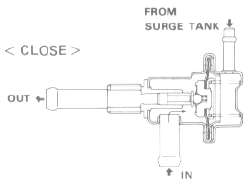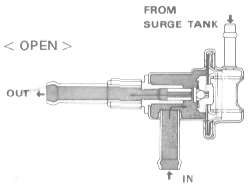Fuel Pump
Fuel PumpFUEL PUMP
The fuel pump is operated by a DC motor that is directly coupled to the pump. Fuel from the fuel cock is drawn into the pump, flows around the motor to the outlet at the opposite end of the housing, and then is fed through the check valve.
The fuel pump is connected to the electric starter circuit and begins pumping fuel when the starter is made to operate. The pump is protected by the circuits that sense AC generator output should the engine stall and a ballast switch, which shuts the fuel pump off should the motorcycle fall over.
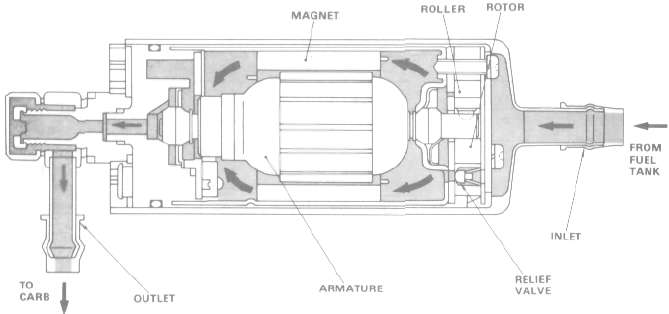
The pump is made up of a housing, a rotor, and a series of rollers. While the rotor is turning, the rollers, which are pushed against the housing by centrifugal force, trap fuel. The fuel thus trapped is squeezed out as the rotor further turns. In the event of restricted fuel flow in the system, a spring loaded relief valve is used to work at 2.5 kg/cm2. This valve relieves excess pressure that could build up in the fuel system.
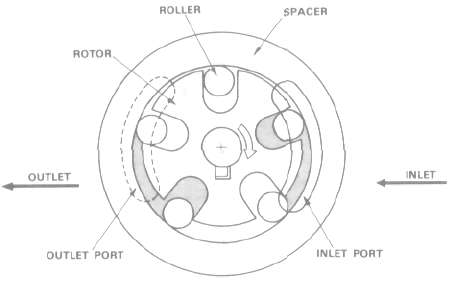
FUEL PUMP CIRCUIT
This fuel pump can run when the starter motor is running or when the engine is running.
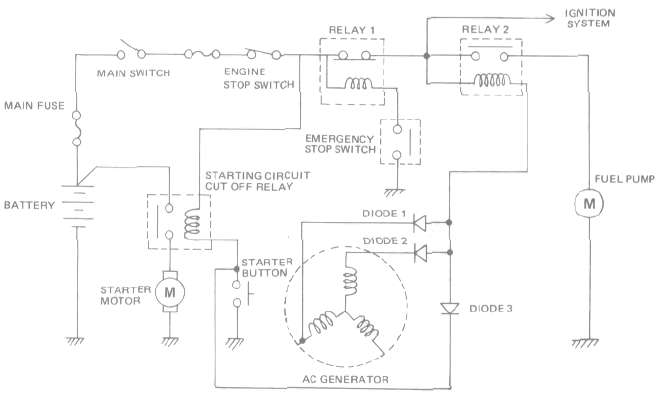
FUEL PUMP OPERATION
1. Main Switch On:
The ignition system circuit is closed, but the fuel pump will not run.
2. Electric Starter Button On:
The electric starter begins to operate. Relay 2, in parallel with the electric starter, closes, thereby making the fuel pump operate,
3. Engine On.
When the engine is turned over, the AC generator creates voltage which keeps relay 2 on and the pump running.
4. Engine Stalls:
If the engine stalls, the AC generator does not produce voltage. Relay 2 is turned off, stopping the fuel pump. No other switches need be turned off.
5. Motorcycle Falls:
Should the motorcycle go down, the ballast switch turns on and relay 1 is turned off. This opens the ignition circuit which kills the engine. At the same time, the pump is also cutoff from its power supply and stops running.
Fuel pump specifications:
Consumption amperage: 2A or less
Output pressure: 98.1 kPa (1.0 kg/cm3, 14.2 psi)
CHECK VALVE
This valve replaces the traditional vacuum fuel cock. It is fitted to the system to prevent fuel flow to the carburetors when the engine is not running. If a pressure of 19.6 kPa (0.2 kg/cm3, 2.8 psi) is created on the intake side of the valve, fuel flow will be 3.5L/hour to the carburetors.
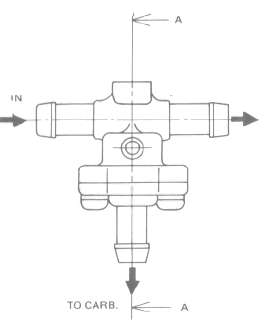
SECTION A-A:
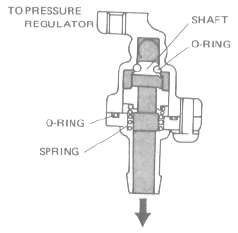
PRESSURE REGULATOR
This regulator is closed when the engine is at a stop and open when the engine is running, thereby controlling the feed pressure (i.e., fuel flow) in the range of the charging pressure plus an additional 0.2 kg/cm2. Spring-and-diaphragm control of pressure is used to ensure the proper manifold-/fuel pressure difference. The spring end of the regulator is thus open to the engine manifold. As the pressure exceeds 0.2 kg/cm1, the diaphragm opens the regulator, causing excess fuel to return into the fuel tank.
